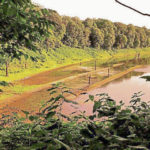Low water brings rare glimpse of old bridge and Pa. Canal at Conemaugh River Lake


Share this post:
Low water levels in the Conemaugh River Lake have exposed some archaeological artifacts: abutments to a railroad bridge and remnants of the Pennsylvania Canal system from the 1800s.
The artifacts in the Conemaugh River Lake, straddling Indiana and Westmoreland counties just east of Saltsburg, were visible over the July Fourth weekend and earlier this week from the West Penn Trail’s Livermore trailhead, just past mile marker 9.
A local historian who documents the remnants of the Pennsylvania Canal and other older transportation structures photographed the bridge abutments and the canal system on Monday.
“With the low water, it was important to take photos because these bridge piers and the canal remnants aren’t seen that often,” said Russell Love of Penn Hills, who has written guides on the Pennsylvania Canal and the Pennsylvania Turnpike. He also runs the Facebook page Pennsylvania Canal.
The stone abutments were all that remained of the original wooden bridge built in 1864 for the West Penn Railroad, according to Love.
In the Conemaugh River Lake area the West Penn Railroad was built parallel to the Pennsylvania Canal, which was a short-lived mode of transportation using canals earlier in the 1800s before railroads reigned.
The Pennsylvania Canal locks were another good find for Love with the Conemaugh River Lake’s low water. The canal started operating in 1834 transporting goods between Philadelphia and Pittsburgh, according to the Pennsylvania Historical and Museum Commission.
The artifacts were no longer visible later in the week.
The low water levels at the Conemaugh reservoir and other reservoirs are expected this time of year, according to officials with the U.S. Army Corps of Engineers.
Although water levels at their multi-purpose flood control dams and reservoirs are at the low end, it has not impacted water levels on the Youghiogheny, Allegheny or Monongahela rivers, according to Megan Gottlieb, the Corps water management unit lead based in Pittsburgh.
So far this summer, none of the Corps’ facilities such as boat ramps and beaches have been closed because of low water at reservoirs in Allegheny and surrounding counties.
Although water levels at Corps dams and reservoirs are at their summer low, the Corps can continue its water releases from multi-purpose dams that hold water to prevent flooding and release water when it’s needed for other purposes.
For example, the Corps releases water from its multi-purpose dam in Confluence for rafting and paddling on the Youghiogheny River and the Kinzua Dam in Warren County for navigation of the Allegheny River.
“The flows into and out of the reservoirs and the amount of water going down the Allegheny and Monongahela rivers are taken into consideration,” said Joe Kolodziej, the Corps’ acting southern area resource manager.“It’s a complicated dance.”
Although the region is not in a state of drought, if it were, all of the multi-purpose dams and reservoirs have drought contingency plans in place, Kolodziej said.



